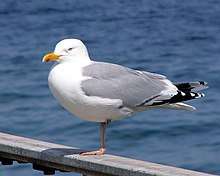Laridae
| Laridae | |
|---|---|
 | |
| European herring gull | |
| Scientific classification | |
| Kingdom: | Animalia |
| Phylum: | Chordata |
| Class: | Aves |
| Order: | Charadriiformes |
| Suborder: | Lari |
| Family: | Laridae Rafinesque, 1815 |
| Genera | |
|
See text. | |
Laridae is a family of seabirds in the order Charadriiformes that includes the gulls, terns and skimmers. It includes around 100 species arranged into 22 genera. They are an adaptable group of mostly aerial birds found worldwide.
Taxonomy
| Laridae phylogeny | |||||||||||||||||||||||||||||||||||||||||||||||||||||||||||||||||||||||||||||||||||||||||||||||||||||||||
|
| |||||||||||||||||||||||||||||||||||||||||||||||||||||||||||||||||||||||||||||||||||||||||||||||||||||||||
| Part of the cladogram of the genera in the order Charadriiformes based on the analysis by Baker and colleagues published in 2007.[1] |
The family Laridae was introduced (as Laridia) by the French polymath Constantine Samuel Rafinesque in 1815.[2][3] Historically, Laridae were restricted to the gulls, while the terns were placed in a separate family, Sternidae, and the skimmers in a third family, Rynchopidae.[4] The noddies were traditionally included in Sternidae. In 1990 Charles Sibley and Jon Ahlquist included auks and skuas in a broader family Laridae.[5]
A molecular phylogenetic study by Baker and colleagues published in 2007 found that the noddies in the genus Anous formed a sister group to a clade containing the gulls, skimmers and the other terns.[1] To create a monophyletic family group, Laridae was expanded to include the genera that had previously been in Sternidae and Rynchopidae.[6][7]
Baker and colleagues found that the Laridae lineage diverged from a lineage that gave rise to both the skuas (Stercorariidae) and auks (Alcidae) before the end of the Cretaceous in the age of dinosaurs. They also found that the Laridae themselves began expanding in the early Paleocene, around 60 million years ago.[1] The German palaeontologist Gerald Mayr has questioned the validity of these early dates and suggested that inappropriate fossils were used in calibrating the molecular data. The earliest charadriiform fossils date only from the late Eocene, around 35 million years ago.[8]
Anders Ödeen and colleagues investigated the development of ultraviolet vision in shorebirds, by looking for the SWS1 opsin gene in various species; as gulls were the only shorebirds known to have developed the trait. They discovered that the gene was present in the gull, skimmer and noddy lineages but not the tern lineage. They also recovered the noddies as an early lineage, though the evidence was not strong.[9]
Noddies[lower-alpha 1]
- Genus Anous (5 species)
- Genus Gygis (white tern)[lower-alpha 2]
Skimmers
- Genus Rynchops (3 species)
Gulls
- Genus Creagrus (swallow-tailed gull)
- Genus Rissa (kittiwakes) (2 species)
- Genus Pagophila (ivory gull)
- Genus Xema (Sabine's gull)
- Genus Chroicocephalus (11 species)
- Genus Hydrocoloeus (little gull)
- Genus Rhodostethia (Ross's gull)
- Genus Leucophaeus (5 species)
- Genus Ichthyaetus (6 species)
- Genus Larus (24 species)
Terns
- Genus Gelochelidon (gull-billed tern)
- Genus Hydroprogne (Caspian tern)
- Genus Thalasseus (7 species)
- Genus Sternula (7 species)
- Genus Onychoprion (4 species)
- Genus Sterna (13 species)
- Genus Chlidonias (4 species)
- Genus Phaetusa (large-billed tern)
- Genus Larosterna (Inca tern)
Distribution and habitat
The Laridae have spread around the world, and their adaptability has likely been a factor. Most have become much more aerial than their ancestor, which was likely some form of shorebird.[10]
Notes
- ↑ The genera are listed in taxonomic order.[6]
- ↑ There is discussion in the IOC about renaming this species "white noddy" to reflect its relationships
References
- 1 2 3 Baker, A.J.; Pereira, S.L.; Paton, T.A. (2007). "Phylogenetic relationships and divergence times of Charadriiformes genera: multigene evidence for the Cretaceous origin of at least 14 clades of shorebirds". Biology Letters. 3: 205–209. doi:10.1098/rsbl.2006.0606. PMC 2375939. "Erratum: Phylogenetic relationships and divergence times of Charadriiformes genera: multigene evidence for the Cretaceous origin of at least 14 clades of shorebirds". Biology Letters. 4: 762–763. 2008. doi:10.1098/rsbl.2006.0606erratum.
- ↑ Rafinesque, Constantine Samuel (1815). Analyse de la nature ou, Tableau de l'univers et des corps organisés (in French). Palermo: Self-published. p. 72.
- ↑ Bock, Walter J. (1994). History and Nomenclature of Avian Family-Group Names. Bulletin of the American Museum of Natural History. Number 222. New York: American Museum of Natural History. pp. 138, 252.
- ↑ Christidis, Les; Boles, Walter E. (2008). Systematics and Taxonomy of Australian Birds. Canberra: CSIRO Publishing. p. 128. ISBN 978-0-643-06511-6.
- ↑ Sibley, Charles Gald & Ahlquist, Jon Edward (1990): Phylogeny and classification of birds. Yale University Press, New Haven, Conn.
- 1 2 Gill, Frank; Donsker, David, eds. (2017). "Coursers, noddies, gulls, terns, auks & sandgrouse". World Bird List Version 7.2. International Ornithologists' Union. Retrieved 21 April 2017.
- ↑ Burger, J.; Gochfeld, M.; Bonan, A. "Gulls, Terns, Skimmers (Laridae)". In del Hoyo, J.; Elliott, A.; Sargatal, J.; Christie, D.A.; de Juana, E. Handbook of the Birds of the World Alive. Lynx Edicions. Retrieved 22 April 2017. (Subscription required (help)).
- ↑ Mayr, Gerald (2011). "The phylogeny of charadriiform birds (shorebirds and allies) – reassessing the conflict between morphology and molecules". Zoological Journal of the Linnean Society. 161 (4): 916–934. doi:10.1111/j.1096-3642.2010.00654.x.
- ↑ Odeen, Anders; Håstad, Olle; Alström, Per (2010). "Evolution of ultraviolet vision in shorebirds (Charadriiformes)". Biology Letters. 6 (3): 370–74. doi:10.1098/rsbl.2009.0877. PMC 2880050.
- ↑ Moynihan, Martin (1959). A revision of the family Laridae (Aves) (PDF). American Museum Novitates. Number 1928. New York: American Museum of Natural History.
- Grant, Peter J. (1986) Gulls: a guide to identification ISBN 0-85661-044-5
- Howell, Steve N. G. and Jon Dunn (2007) Gulls of the Americas ISBN 0-618-72641-1
- Olsen, Klaus Malling & Larsson, Hans (1995): Terns of Europe and North America. Christopher Helm, London. ISBN 0-7136-4056-1